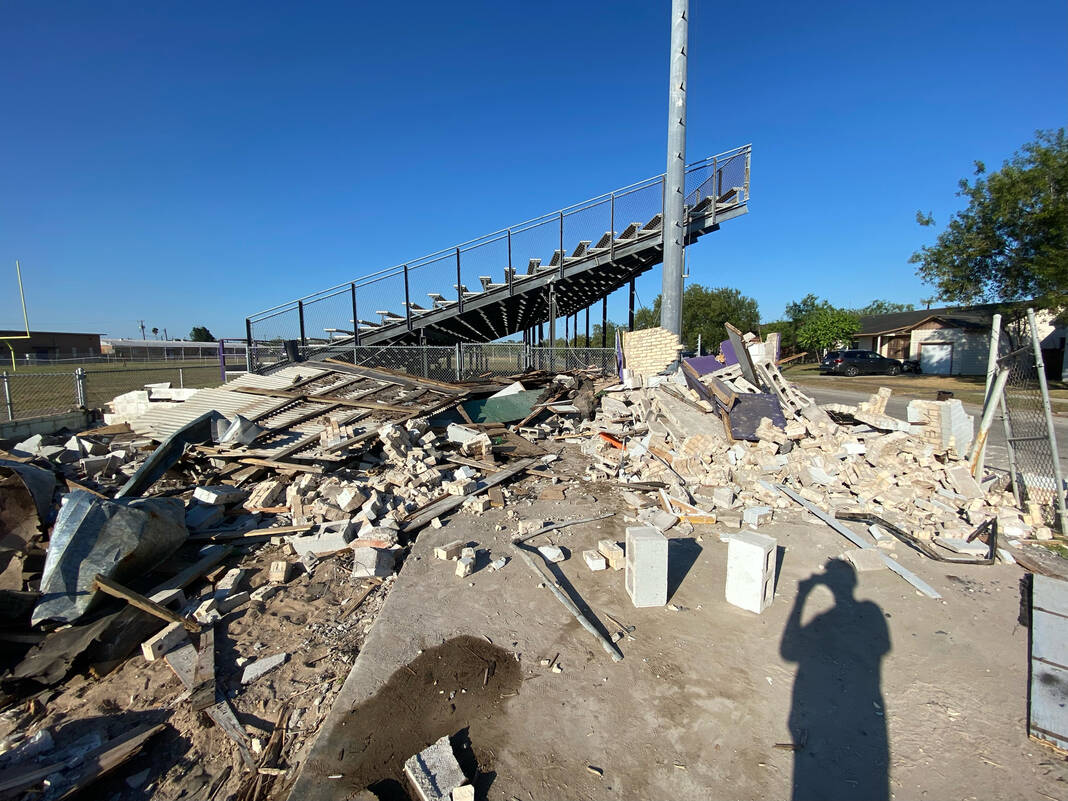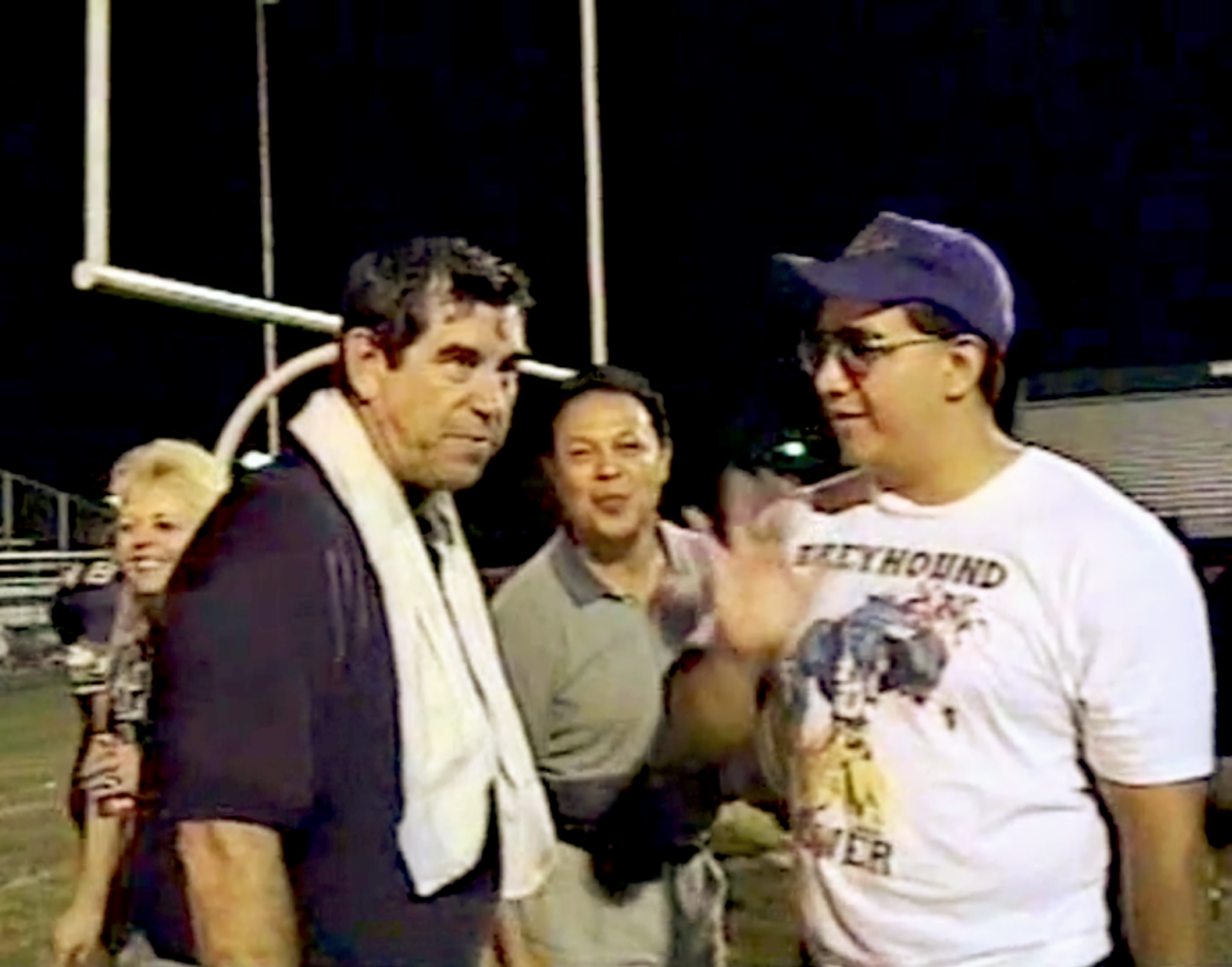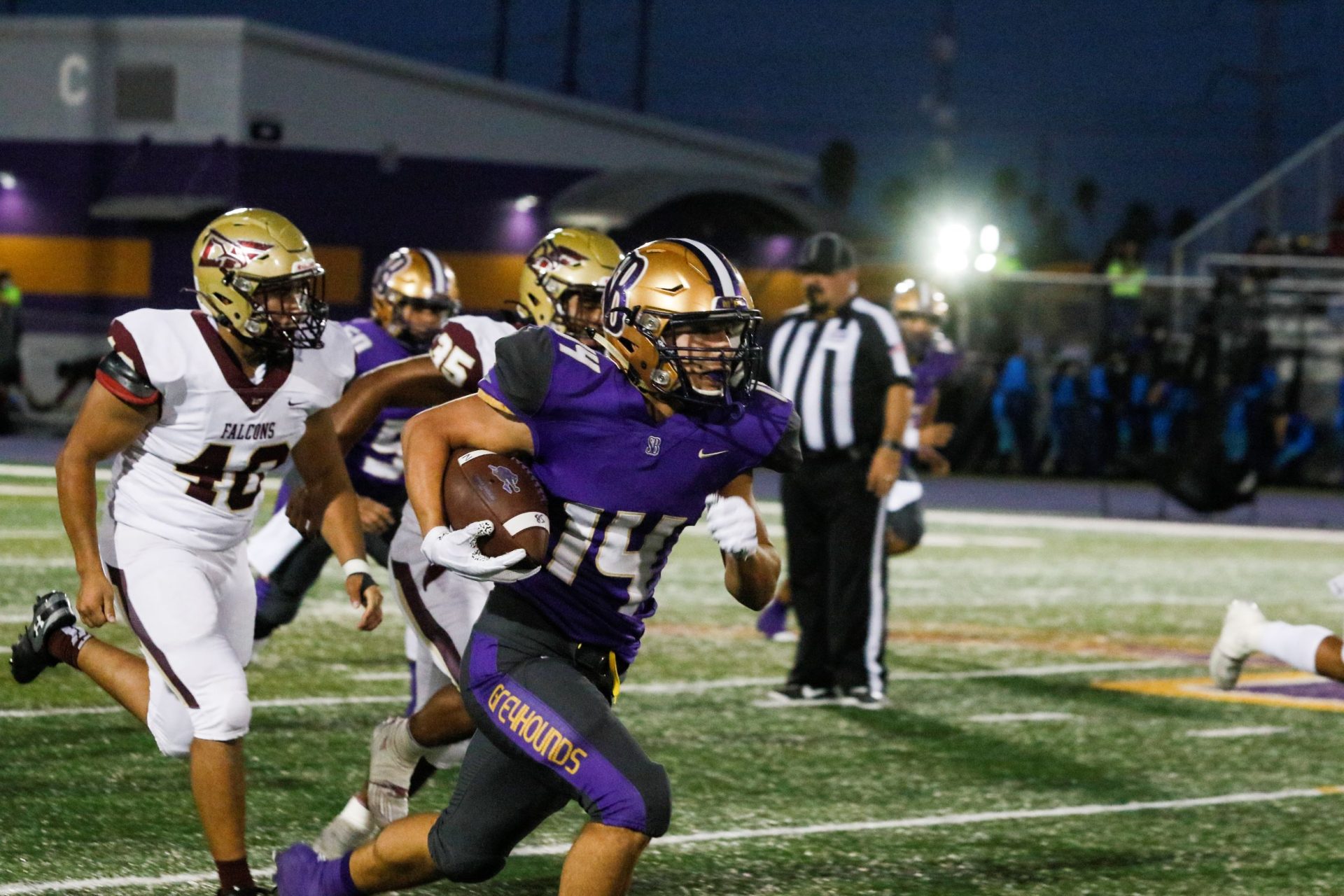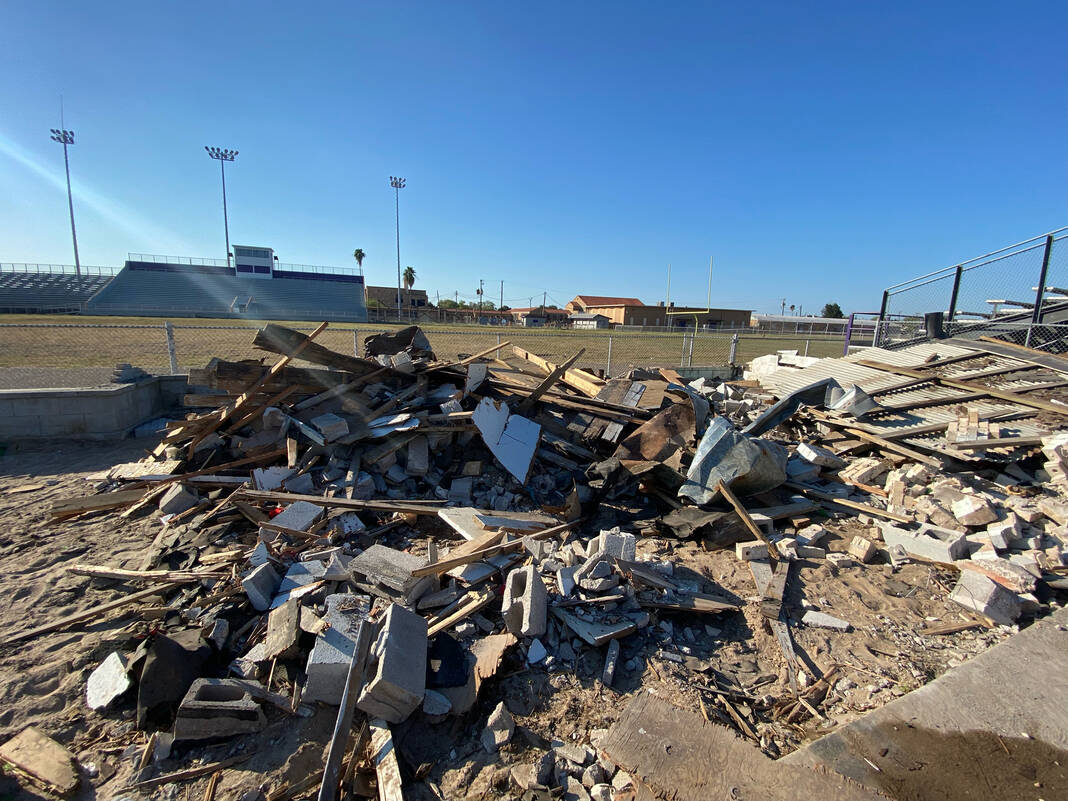|
Only have a minute? Listen instead
Getting your Trinity Audio player ready...
|
When the San Benito school district announced in June that it was temporarily closing Greyhound Stadium, the reaction then was arguably more tepid. This may be since the football field belonging to this proud city’s former high school was anything but mortal at the time.
Yes, it hasn’t been the home of Greyhound football since 2006, when the $4.5 million Bobby Morrow Stadium opened with a $500,000 scoreboard, but the old venue remained beloved and was still in use by the general public. People went there for a brisk walk or jog, kids played football or soccer on that storied grass, and some just sat and contemplated on the bleachers that once shook with excitement.
It was still home.
The school district’s announcement did come with some notable alarm at the time. The term “unsafe zone” was used, and by August, officials said a licensed engineer found that “excess steel corrosion” had compromised the structural integrity of the bleachers. It led to the “utmost concern” and the stadium remained closed pending a decision from the school board and administration.
No one knew what that meant, and everyone knew exactly what that meant. Home was about to change forever.
About a month later, in September, people began noticing construction crews at the retired stadium doing the unthinkable: they were knocking down some of the bleachers. And while their deterioration made them hazardous, there are many who are not ready to say goodbye to the uncomfortably cold steel seating that once warmed so many hearts.
Thursday night, the district once again took to social media with an update. The center section of the away seating is gone, and the north section of the home bleachers, the general admission section, has been torn down.
“The demolition is currently underway, and the next step is the removal of all demolition-related debris. Shortly thereafter, Greyhound Stadium will reopen,” the district said in Thursday’s statement. “For the next few weeks, Greyhound Stadium will remain a no trespassing zone. For everyone’s safety, District administrators respectfully request that everyone abide by the signage posted in numerous areas along the stadium’s perimeter fencing.”
It’s safe to say now that the reaction has grown from tepid to full on lament.

PURPLE THUNDER
Greyhound Stadium is located at North Bonham and East Hicks streets in San Benito. It’s nestled in a residential area with no surrounding businesses or public offices, only homes, as though the stadium is a residence itself — home to the Greyhound faithful, and a traditional house in almost every sense of the word.
It’s one of the only high school football stadiums in the state that has this nuance. Residents who couldn’t buy tickets to the games would line up outside the fence to watch, and because the stadium sits in the middle of a neighborhood, some would be perched on their roofs hoping to catch a glimpse of the action on Friday nights.
Then there were the fans, the first 12th man before any other team or fan base could claim that moniker, at least according to some San Benito residents.
Whenever the team was playing defense, fans stomped on those steel and aluminum bleachers to make noise in an effort to encourage the Greyhounds and intimidate the opponents. They shook beneath your feet and produced a rumbling sound that began as a hum and crescendoed to a deafening tremor, not unlike the sound of thunder. In fact, the team’s nickname is Purple Thunder.
Fans throughout the years, such as the late Peter Galvan, who died in July at the age of 72, have become characters in this story that are as iconic as the stadium itself. In Peter’s case, he customized his motorcycle into a purple and gold tribute to San Benito High School, and rode it to the games and all around town, garnering honks and waves and smiles.
For others, they took a bass drum to games and led “Go Hounds Go” chants, cardboard cutouts of a “D” and a fence to shout “defense,” and then there is the Greyhound Hair Club — a group of friends and fans who showed up to home games in purple wigs and face paint.
This town of around 24,000 people with a high school graduation rate of 97%, where the median household income is around $33,000 annually, and where about 36% of the population live in poverty, is filled with people whose football team makes them feel on top of the world.
That’s no easy task in a community that’s suffered political turmoil in its local governments for decades.
Such is the spirit of the South Texas town affectionately referred to as the Resaca City, for the river that runs through it, that many have taken offense to its perception in the media.
In November 2006, another publication in Texas covered the story about Bobby Morrow Stadium’s opening, which stated that 1 in 2 children were expected to drop out of high school and were also eligible for free school lunches. It further stated that the town “clings to its modest circumstances much like the rest of the Rio Grande Valley,” and that residents’ “minimum wages” kept its “tattered downtown busy” — all in the story’s opening two paragraphs.
Many residents of San Benito remember those words with disdain.
Hector Avila, a 61-year-old lifelong Greyhound fan, doesn’t define the city by its demographics or economy alone, at least not as “limitations” like the article in question stated. He said a love for home drives many of the hearts and minds of San Benito residents, and that there’s nothing wrong with that.
Greyhound Stadium is simply the place where you witnessed that sentiment’s convergence with the city’s passions.
“I’ve never lost that passion,” Hector said Wednesday. “There wasn’t much to do in San Benito but you could always look forward to Friday night at that stadium. There was that close-knit fan base.”

‘I’VE NEVER SEEN ANYTHING LIKE THAT’
There is no bigger game in San Benito than the Battle of the Arroyo, the annual grudge match against the neighboring Harlingen Cardinals. And in 1995, San Benito defeated the Cards for the first time since 1967, 15-6, at Greyhound Stadium.
Hector, like anybody from San Benito, remembers that game vividly. In fact, he filmed much of it and often goes back to it for nostalgia’s sake.
The class of 1981 San Benito High graduate, who ran track at the time and now works as a process server and as a transport specialist, said the stadium was magical then. It held the hopes of a town that for too long felt inferior to their bigger, richer neighbors. Vandalizing of each other’s stadiums and even the water tower in San Benito were common.
When wide receiver Jason Montemayor scored on a 44-yard strike from quarterback Eddie Benavidez in the fourth quarter, it sealed the deal and fans erupted. Then, when the clock struck zero, the fans in attendance cheered for what seemed like an eternity. One could barely hear their own voice. The sea of red-clothed Harlingen fans in attendance just sat there, stunned.
Many of the Greyhound fans rushed the field that night, including Hector. He recalled talking to then-head football coach Tommy Roberts and the late Buddy Green, who served as the Valley Morning Star’s sports editor at the time.
He remembers those conversations well.
“Everyone just went crazy,” Hector recalled, noting that he had the chance to speak to the coaches, and to Green. “I said, ‘Hey Buddy, you can write that the curse is over.’ And he said, ‘Yep, the curse is over.’”
Fans also took to the streets in an impromptu victory parade that night, with cars bumper to bumper and arms outstretched from within the vehicles holding fists in the air or pom poms. The local Stars Drive-in, which is located just down the street from the stadium, was a popular hangout after the games and was packed that fateful evening.
“It was something that for years we still celebrate, sort of like when the Red Sox won the pennant,” Hector said. “I’ve never seen anything like that. It was crazy. It was one of those things where man if I die tomorrow I’d die a happy man.”
Greyhound fandom is a family affair for the Avilas. His wife, Betsy Avila, is a 59-year-old retired Dillard’s assistant manager at the Valle Vista Mall in Harlingen. She’s also a 1983 graduate of Harlingen High who converted to a full-blown Greyhound around 2000.
Their daughter, 23-year-old Cassandra Leaanne Avila, is also a fan.
The family has been season ticket holders for 33 years. Hector himself has never missed a Battle of the Arroyo, at least not since 1974, and is looking forward to his heavily touted ’Hounds lining up against the Cardinals for the 111th time since 1913 on Friday, Oct. 20, at Bobby Morrow Stadium.
And although he loves the more modern digs — named after the late Olympic gold medalist and former world’s fastest man, Bobby Morrow, who hailed from San Benito — Hector said there was something special about Greyhound Stadium that hasn’t been replicated.
“The feeling I got when I first went into that stadium, I was mesmerized,” he said. “I remember hearing stories about that stadium and the fans and I was like in awe.”
Remembering a conversation he had with the KRGV sports director Dave Brown, who died in June, Hector said he always liked how Brown described the atmosphere at Greyhound Stadium.
“He said that when he came to San Benito, that was one of his favorite stadiums because it’s inside the neighborhood and it kind of reminds him of the Boston Red Sox and Fenway Park, how it’s situated,” Hector recalled. “It made for a real home advantage and cozy feeling.”

‘MEMORIES WILL NEVER BE TAKEN DOWN’
Mary Lou Saldaña often expressed pride in being from San Benito. She actually married a Greyhound — Reynaldo R. Saldaña, who was a member of the 1961 team that made it to the semifinals but lost in the final seconds in heartbreaking fashion to Nederland, 22-15.
The two became parents to three children, one of whom also played football, Ray Saldaña Jr.
To say the Saldañas were rooted in Greyhound history would be an understatement. To say that the community mourned Mary Lou and Ray Sr. when they died would be a gross understatement.
Mary Lou, 77, died in February and Ray Sr., 78, died six months before her in August 2022.
Ray Jr. spoke about what the team, the community and the stadium meant to them Friday.
“My mom was proud about being the first Hispanic drum majorette, and my dad played with the semifinal team with Jim Helms. This place holds a special place in the hearts of not only my family, but it means a lot to a lot of people,” Ray Jr. said.
“There was just something about that stadium where the fans were really close,” Ray Jr. added. “The bleachers were closer to the team. I think we really loved the proximity of the fans to us. It just seemed to be louder.”
He spoke about his mom being passionate about her family and her team, and how she couldn’t handle being without her husband.
Now serving as executive director of operations for San Benito CISD, Ray Jr. also discussed with the Valley Morning Star the Battle of the Arroyo record and how it’s always in dispute, when the stadium was first built, and that the demolition of its bleachers has everyone talking.
It had to be done, Ray Jr. said.
Hector agreed.
“You can knock them down and eventually they were going to have to,” Hector added. “They’re doing whatever they have to do, but I can’t say that I’m super sad because the memories will never be taken down or erased from your mind.”





